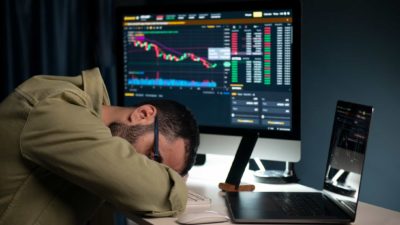This article was originally published on Fool.com. All figures quoted in US dollars unless otherwise stated.
Day traders, beware. There's an ever-growing mountain of evidence that even the most sophisticated professionals can't consistently outperform the market -- most of them don't even beat index fund benchmarks in any given single year. If you plan to figure out which days stocks will rise and fall, it might be time to consider a new strategy. Luckily, there are investment strategies that don't require you to perfectly predict the stock market, but they'll still deliver fantastic returns regardless of timing.You need to time it more than once
This is one of the simplest challenges in active management, but it's almost always overlooked. In the most basic sense, you make money by buying stocks low and selling them high. That means you have to figure out not only when to buy a stock but also when to sell it. If you think that a stock is cheap and it's a great time to buy, that's fine. But you have to recognize that you only take profits by selling in the future. The same applies if you think that a stock is expensive and it's time to get out -- you're creating a future obligation to buy back in, and you'll need to determine when to actually execute that trade. If the probability of perfectly timing a market bottom is low, then the probability of doing so followed by perfectly timing a market top is much slimmer. Even worse, daily return data from stock indexes indicates that there's very little margin for error. You might think that timing things correctly within a few weeks or months can be successful, but you actually need a lot more precision.A small number of days generate a large proportion of returns
There are numerous studies showing the same pattern across different time periods -- the S&P 500's growth can be entirely attributed to a small number of days. One paper found that over a 20-year span, the 35 best days accounted for all of the gains in that period. That's less than 1% of the more than 5,000 trading days across two decades. Even more frustrating, many of the market's best days occur within a week of the worst days. That's trouble. Consistently timing the market would therefore require incredible precision. Any active traders seeking to time the market may have completely sabotaged their performance if they happened to miss out on any of that small handful of days. If you stay invested, you're implicitly "buying" on down days. If you get too active, you run the risk of buying high and selling low. Investors need to understand the mechanics of how markets fluctuate. Most price movements are modest, and they usually have no connection to news about corporate financial returns. The average month has four days where the index gains or loses more than 1%. Otherwise, there are slightly more upward days than down days. Individual stocks behave similarly, though each stock tends to have days where it fluctuates a bit more than the major indexes. The key to consistent long-term growth is to be invested when those big marketwide growth days hit. It also helps to own at least a handful of stocks that deliver fundamental growth in a way that can outpace the market. If you hold a few different stocks for the long term, then you'll increase the likelihood that you'll share in the returns when those great sessions happen to hit.Entry points are less important over the long term
It's hard to argue with the overwhelming evidence above, but the promise of big profits is still alluring. It can make investors act irrationally and ignore their better judgment. If you're still tempted, it might help to recognize that entry points become less and less meaningful over the long term. Within a given year, the exact day that you purchase a stock can make the difference between big gains and big losses. That's very much not the case if you're looking at a 20-year window. Bank of America published a paper recently that quantified the effects of missing the 10 best and worst trading days for each decade, based on S&P 500 daily returns. The authors found that someone who had invested in the S&P 500 from 1930 through 2020 would have achieved nearly an 18,000% return. If someone happened to miss the 10 best days of each decade, that number drops to 28%. The authors noted that it can take more than 1,000 trading days to overcome bear markets, and valuation is by far the most accurate predictor of returns over a 10-year period. Again, this shows that a good long-term allocation is a superior strategy to picking stocks for short-term returns. It's okay to make modest adjustments to your stock portfolio as conditions change for the individual company, the stock market as a whole, and the economy. However, investing for short-term gains is something that even the majority of professionals cannot do successfully and consistently.This article was originally published on Fool.com. All figures quoted in US dollars unless otherwise stated.









